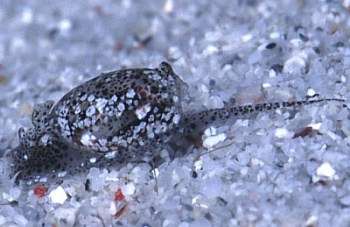
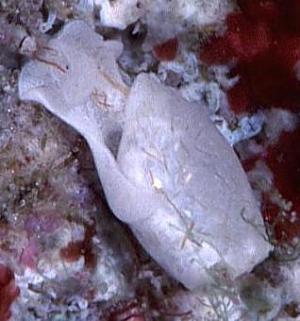
haminoeid - genus unknown 1.
Order: CEPHALASPIDEA
Superfamily: HAMINOEOIDEA
Family: Haminoeidae
PHOTO
UPPER: Common species in Kerama Is. [near Okinawa], Japan. They are seen in May and June. 3m depth, 10mm long. LOWER: 10m depth, Kerama Is. near Okinawa, Japan. Shell-length is 3mm long. PHOTOS: Atsushi Ono.
Two related species are together on this page.
See messages from Atsushi Ono and Clay Carlson & Patty Jo Hoff.
See messages about a second species, probably of the same genus from Atsushi Ono, Clay Carlson & Patty Jo Hoff and a second by Clay Carlson & Patty Jo Hoff.
Authorship detailsRudman, W.B., 1999 (August 10) haminoeid - genus unknown 1. [In] Sea Slug Forum. Australian Museum, Sydney. Available from http://www.seaslugforum.net/find/miniham
Related messages
Re: Long-tailed mini haminoeid from New South Wales
May 26, 2007
From: Clay Carlson
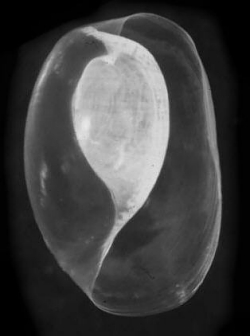
Concerning message #19867:
Bill,
Here is a shell to go along with Nerida's 'miniham'. Her posting spreads the distribution of 'C.36' a bit further south. Last year, Michael Schroedl sent us a photo of the same species from Fiji.
The tail of this animal as well as one of our other minihams appears to be defensive in nature. At least, when attacked by an eye-dropper, the animal jerked back to it's point of attachment. This is when we found them on mats of cyanobacteria.
Locality: Toguon Bay, 7, Guam, 23 March 1988. Length: [shell 3.3 x 2.2mm], specimen 4.5mm excluding tail. Photographer: Carlson & Hoff.
Clay & Patty Jo
ccarlson@guam.net
Carlson & Hoff, 2007 (May 26) Re: Long-tailed mini haminoeid from New South Wales. [Message in] Sea Slug Forum. Australian Museum, Sydney. Available from http://www.seaslugforum.net/find/19956Thanks Clay,
I had always associated long sticky 'tails' with adaptations for 'hanging on' such as Stylocheilus longicauda living on floating algae in the open sea, but it of course makes perfect sense if some animals use a sticky tail for pulling the body away from danger. Very interesting
Best wishes,
Bill Rudman
Long-tailed mini haminoeid from New South Wales
May 7, 2007
From: Nerida Wilson
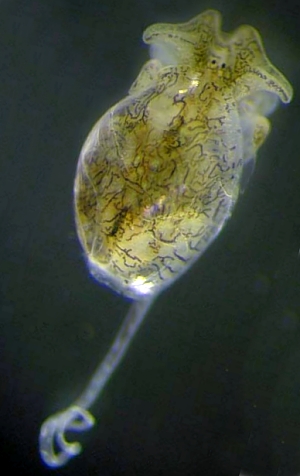
Concerning message #1160:
Dear Bill and others,
I thought I would share some images of this interesting little haminoeid. The specimen was partly damaged during collection, but it retained its amazing extensible 'tail'. The picture that I have uploaded here does not show the full length of its extension, but close enough. The animal was about 1.5 mm long, excluding tail of course!
Locality: Port Stephens, 1 m, NSW, Australia, Pacific Ocean, 12 April 2007. Length: 1.5 mm. Photographer: Greg Rouse.
Nerida Wilson
ngwilson@ucsd.edu

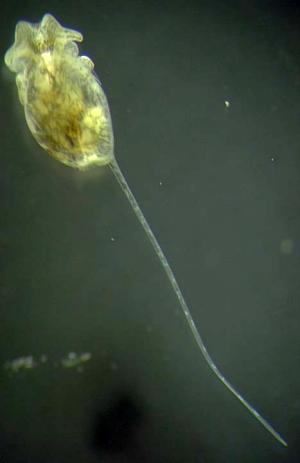
Dear Nerida,
Thanks for this little cephalaspid that Clay Carlson calls a 'miniham'. It's exciting to know they can be found so close to Sydney. I wonder what the 'tail' is for?
Best wishes,
Bill Rudman
Re: Haminoeid from Kerama Id
October 13, 2000
From: C. Carlson & P.J. Hoff
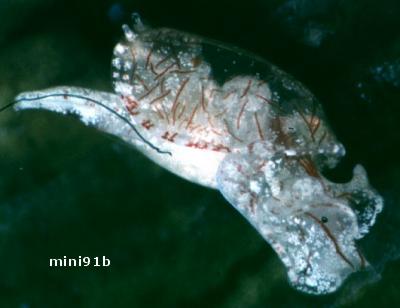
Bill,
We think that Atsushi's white shelled form is the same as our white 'miniham'. I have attached two scans of an animal from Yap that shows some of the modification of the head shield. Our first mnemonic for this animal was 'poodle head'. We have one specimen from Guam that has no brown lines. The Kerama specimen seems to show a hint of the short brown
lines ala the form from Yap. The external morphology of the white form appears identical to our most common miniham. The tail is relatively short, there are projections on the posterior pallial lobe and the lobes on the head shield extend at right angles from the head. I have attached a photo of a gizzard plate of the common mini24. If the white form is the same, the radula will be 2.1.2 with a broad, smooth, concave bladed rachidian. The two laterals will have denticulate outer edges. [you already have a scan of the shell of C.24 [=mini24]].
• mini91a, mini91b 3mm; Yap, Miil channel, 13m; 4 January 1994
• mini24_5 gizzard plate, 2.5mm specimen; Guam, Bile Bay, 4m; 19 April 1988.
Clay & Patty Jo
clay.carlson@kuentos.guam.net
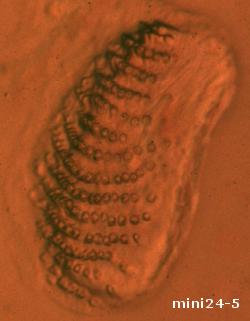

Dear Clay & Patty Jo,
These are interesting little animals. In both of your photos the small papillae radiating out from the flap of skin covering the rear end of the shell (posterior pallial lobe) are very noticeable.
Best wishes,
Bill Rudman.
Diaphanid from Kerama Id is haminoeid
October 10, 2000
From: C. Carlson & P.J. Hoff
Bill,
Atsushi's white slug is another 'miniham' form [see our earlier discussion re unknown genus #1 and
shell of c24]. We haven't done any work on this species since we have only have one specimen. It was good to see the Kerama specimen since this adds some credence to the white form being a separate species.
I'll try to dig up a good head shot of c24. The white form (c91) and c24 appear identical except for the color.
Clay & Patty Jo
clay.carlson@kuentos.guam.net
Carlson, C. & Hoff, P.J., 2000 (Oct 10) Diaphanid from Kerama Id is haminoeid. [Message in] Sea Slug Forum. Australian Museum, Sydney. Available from http://www.seaslugforum.net/find/3155Dear Clay & Patty Jo,
I hoped you would recognise this animal. The shell reminded me of a diaphanid, but the animal looked much like a haminoeid. At this stage I'll put them altogether on the same genus page
Best wishes,
Bill Rudman.
A diaphanid from Kerama Island?
October 9, 2000
From: Atsushi Ono
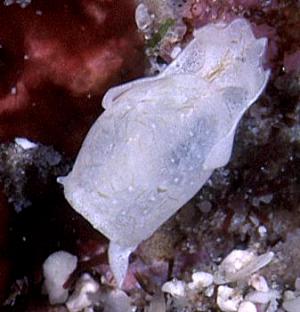

Dear Bill,
Thank you for your comment on Ceratosoma gracillimum.
Now, I attached two images of an animal that I don't know what it is. Maybe I think that is an opisthobranch....
I found it near the base of a colony of the coral Porites sp at 10m depth in a bay at Kerama Is. near Okinawa in Japan.
Shell-length is 3mm long.
Could you help me to identify this for me?
Sincerely,
Atsushi Ono
ononini@cosmos.ne.jp
Ono, A. , 2000 (Oct 9) A diaphanid from Kerama Island?. [Message in] Sea Slug Forum. Australian Museum, Sydney. Available from http://www.seaslugforum.net/find/3143Dear Atsushi,
I don't recognise this tiny animal but it is an opisthobranch. From the the shape of the shell it is possibly a species of Diaphana, but the only species of that genus we have any information on have a rather differently shaped animal, with a longer foot which splits posteriorly into two pointed 'tails' and it does not have parapodial flaps as in your photos.
So all I can say is that it is an opisthobranch. Hopefully someone will recognise it.
Best wishes,
Bill Rudman.
Is this an opisthobranch?
August 11, 1999
From: Atsushi Ono

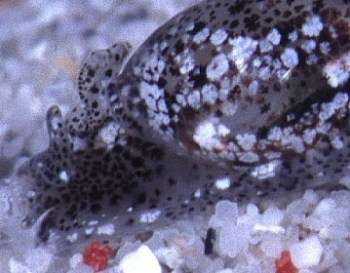
Dear Bill,
I found these small animals on a shallow sandy bottom. This is common species in Kerama Is. [near Okinawa] in Japan. They are seen in May and June. 3m depth, 10mm long.
This animal has small black patches on his translucent body. This animal has a shell and is similar to a mouse! Could you help me to identify this animal? Is this opisthobranch?
Sincerely,
Atsushi Ono
ononini@cosmos.ne.jp
Ono, A., 1999 (Aug 11) Is this an opisthobranch?. [Message in] Sea Slug Forum. Australian Museum, Sydney. Available from http://www.seaslugforum.net/find/1160Dear Atsushi,
I had a feeling that Clay Carlson & Patty Jo Hoff had discussed this animal with me before so I asked them for advice. They say it is one of a group of cephalaspid bubble shells related to Haminoea, and have sent a separate message with pictures of the shell and a gizzard plate.
Bill Rudman.
Re: is this an opisthobranch?
August 11, 1999
From: C. Carlson & P.J.Hoff
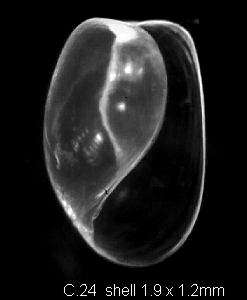
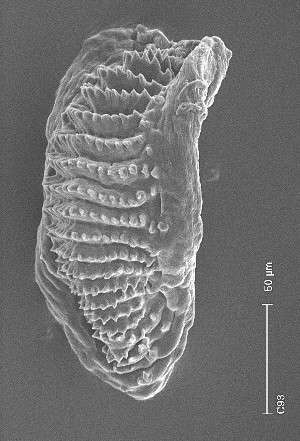
Bill,
Atsushi Ono's animal is actually a haminoeid form.
We have 7 species from Guam that appear to represent a new genus. The shell is very thin and transparent with little or no fold of the columella. It is delicate enough that it can be broken with a light jet of water. The gizzard plates are lightly chitinized with ridges made up of single rows of rods. The radulae that we have looked at have a
formula of 2.1.2. Some of these have been asymmetric; the outer edge of the first left lateral being denticulate and the corresponding right lateral, smooth. Externally the group is marked by a modified head shield, very thin parapodia and an extended tail. In at least two species there is an adhesive area at the end of the tail. When threatened, the animal jerks back to its point of attachment. We have one of the least modified forms on Mike Miller's web site as Branch of the Week #109.
UPPER PHOTO (C.24) Shell, 1.9 x 1.2; 2.7mm live (w/o tail); Guam, Bile Bay, 4m; 19 April 1988
LOWER PHOTO: (C.93) Gizzard plate; animal w/2.1 x 1.25mm shell; Guam, Bile Bay, 12m; 3 July 1998
Unless we have a good view of the head shield, we cannot tell if Mr Ono's specimen is the same as any of the Guam specimens.
(The C.24, C.93 are code numbers in our species list. The animal shown on Mike's site is C.94.)
Clay & Patty Jo
Merizo, Guam
clay.carlson@kuentos.guam.net
Carlson, C. & Hoff, P.J., 1999 (Aug 11) Re: is this an opisthobranch?. [Message in] Sea Slug Forum. Australian Museum, Sydney. Available from http://www.seaslugforum.net/find/1178Dear Clay & Patty Jo,
Thanks for the photos and the information.
Perhaps I saw your interesting animals on Mike's site. You instantly came to mind when I saw Atsushi's photos.
To any of you not familiar with the anatomy of haminoeids, they have a large muscular sac in the oesophagus, which is called the gizzard. It is armed with three large similarly shaped hard plates which are used to grind their plant food. The size, shape and number of the ridges on the plates is quite a useful generic character within the family.
Bill Rudman.
